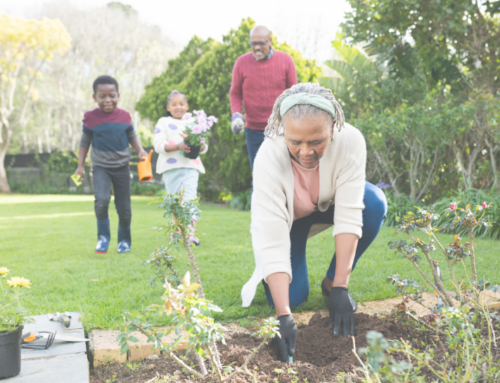HR Champions of Aging-in-Place: Fostering Intergenerational Connections
Attention HR leaders and professionals!
“ The more HR and employers can be explicit about what they stand for and the purpose of the company, the more you’re going to attract your people,” says *Angela Howard, SPHR, founder and Chief Transformation Officer at Angela R. Howard Consulting.
*Angela Howard is a workplace psychologist, coach, and talent management leader. She works part-time as an adjunct professor for the I/O Psychology program at Elmhurst and full-time at Rotary International as an HR and Organization Development Business Partner to management and staff to improve people and business performance through development and an enhanced work experience.
As we navigate a multigenerational workforce, the call for fostering deeper connections between diverse age groups has never been more pertinent.
This article considers Human Resources’ vital role in bridging the gap between the young and old, leveraging aging-in-place nonprofits to enrich our workplaces and communities.
Building on our previous discussion, Investing In Our Future: How Businesses Can Partner with Aging-in-Place Organizations to Foster Intergenerational Programs, we will explore HR strategies for creating harmonious, intergenerational workplaces that bolster company culture and contribute to societal well-being.
Opportunities Abound When Companies Partner with Aging-in-Place Nonprofits
As HR executives navigate the terrain of today’s embrace of social responsibility programs and increased employee engagement, partnering with aging-in-place nonprofits offers a unique and timely opportunity.
- “The population is projected to become older, on average, over the 2024–2054. In CBO’s projections, the number of people aged 65 or older rises, and growth of that group outpaces growth of younger age groups.”
- “The number of Americans ages 65 and older is projected to increase from 58 million in 2022 to 82 million by 2050 (a 47% increase), and the 65-and-older age group’s share of the total population is projected to rise from 17% to 23%.”
- “92% of seniors prefer to age in place. Of the 115 million housing units in the U.S., only 10% have accommodations needed to support those who want to age in place”.
Such partnerships enhance the lives of seniors, allowing them to thrive within the familiarity of their homes. In turn, they give younger employees a sense of purpose and community, positively affecting social responsibility and employee engagement.
With the demographic landscape moving towards an increasingly aging population, there is a hidden opportunity to foster connections between youth’s energy and seniors’ wisdom. There is a growing need to support the older generation, which is determined to age in place.
With this evolution comes an invaluable and crucial opportunity for HR leaders to foster the desire for purpose and service between their younger workforce and seniors. Corporate partnerships, championed by HR leaders, with aging-in-place nonprofits are not just a moral imperative; they are a strategic initiative that can yield many benefits.
The Many Benefits of Partnering with Aging-in-Place Organizations
The benefits of aligning companies’ missions and values with these organizations will strategically enrich their workplaces and communities. The partnerships between companies and aging-in-place non-profits deliver a vision for the future where businesses recognize the changing demographics, embrace the change, and assist those aging at home, showing that caring for people as they age matters and is not all about profits.
The benefits of engaging with aging-in-place organizations include the following:
Enhancing Corporate Culture and Employee Well-Being
- Enhanced Employee Engagement: Young workers feel more invested in a company that supports social causes, increasing overall job satisfaction.
- Strengthened Workforce Compassion: Volunteering fosters empathy and understanding among employees, creating a more supportive workplace culture.
- Talent Attraction and Retention: Companies that demonstrate a commitment to societal issues are more likely to attract and retain employees who value purposeful work.
- Intergenerational Solidarity: Building connections between younger and older generations promotes social cohesion and reduces age-related stereotypes.
Boosting Business Reputation and Community Connection
- Positive Corporate Image: Communities see corporations as responsible citizens, which can improve brand perception and customer loyalty.
- Community Impact: Connections help seniors live comfortably at home, improving the quality of life within the community.
- Legacy Building: Companies can create a lasting impact that resonates with future generations, establishing a legacy of care and connection.
Innovation and Sustainability for Tomorrow
- Innovation Through Diversity: Interaction with diverse age groups can inspire creative thinking and new approaches to problem-solving.
- Sustainability: Supporting aging-in-place contributes to sustainable health and social systems by reducing the demand for institutional care facilities.
HR leaders play an essential role in fostering organizational purpose and progress. Aging-in-place initiatives address both by bringing together the younger workforce and seniors. While partnerships with these non-profits show benevolence, they are also strategic endeavors that support a progressive corporate culture that resonates with communities.
By championing these connections, Human Resources enhances the lived experiences of our aging population and instills a legacy of empathy and purpose in the heart of the workplace.
By aligning with aging-in-place non-profits, this forward-looking approach ensures that employees continue to value care for others, community, and collaboration.
Community Connections Through Aging-in-Place Non-profits
HR leaders are uniquely positioned to steer their organizations toward meaningful collaboration with aging-in-place non-profits.
According to HR Future, three critical areas of CSR help create a cohesive map for the present and future — Community Relations, Training, and Development, and a Cohesive Global CSR Platform.
Community relations include implementing reward programs, making charitable contributions, and encouraging community involvement and practices.
It’s about going beyond the office walls and into the heart of local communities to discover the organizations dedicated to empowering our seniors in their desire to age with dignity in their own homes.
Engaging with these non-profits starts with curiosity—meeting the people behind the mission, understanding the needs of those they serve, and uncovering how a company can lend its support.
Consider it selfish altruism. It demonstrates a commitment to making a positive social impact while enriching company culture and bolstering its brand.
By initiating these partnerships, HR leaders can offer employees avenues for volunteerism and community service that resonate personally, aligning the company’s brand with the values of service and care that are increasingly important to today’s workforce.
A Final Thought
Now is the moment for Human Resources to act—to reach out, build bridges, and incorporate the needs of our aging population into their corporate social responsibility programs.
Change is upon us, and human resource departments and leadership can be at the forefront and start supporting seniors who are aging in place in our communities. By partnering with aging-in-place non-profits, HR leaders can start a movement of compassionate service that ripples through their teams and into the lives of seniors.
Reach out to DSCC or your local aging-in-place non-profits to learn how you can create new pathways for engagement and impact. Connect, contribute, and be the change that bridges generations. Your company can make a profound difference in your community and society.
Sources
- HRCI Learning Center, The Intersection of HR and Corporate Social Responsibility, February 2022
- Congressional Budget Office, January 2024
- RubyHome, Aging in Place Statistics (2024)
- PRB, Fact Sheet: Aging in the United States
- Office of Policy Development and Research, Evidence Matters, Fall 2013
More Articles That Might Interest You
The Caregiving Balancing Act: Support Systems for the Sandwich Generation
The Caregiving Balancing Act: Support Systems for the Sandwich Generation Are you juggling the dual roles of [...]
HR Champions of Aging-in-Place: Fostering Intergenerational Connections
HR Champions of Aging-in-Place: Fostering Intergenerational Connections Attention HR leaders and professionals! “ The more HR and [...]
Bridging Generations: Engaging Activities for Seniors and Youth
Bridging Generations: Engaging Activities for Seniors and Youth Pt. 2 Calling all adult children of seniors, parents, [...]









